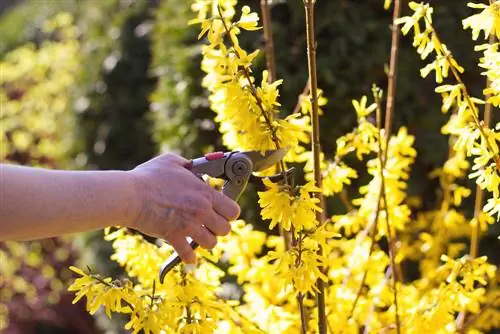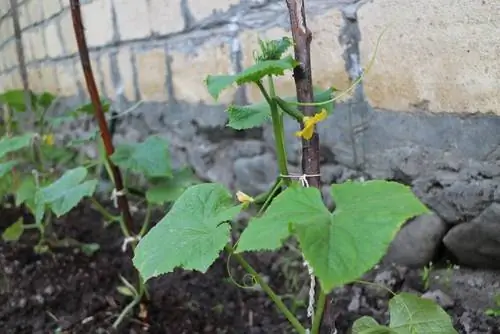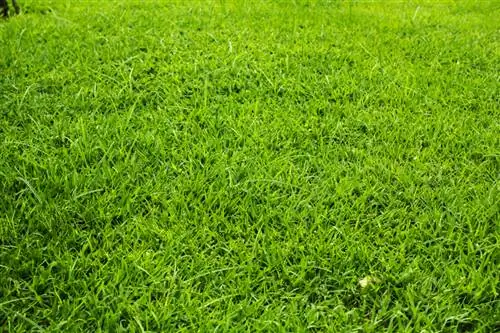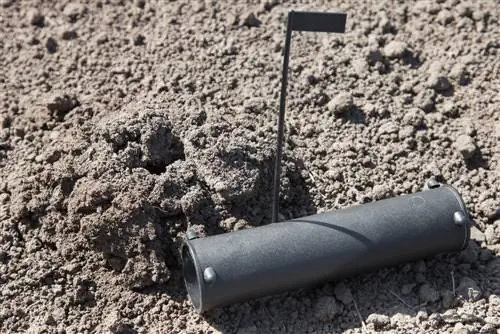- Author admin [email protected].
- Public 2023-12-29 04:51.
- Last modified 2025-06-01 06:02.
The bright yellow spring fairy tale of blooming forsythia depends on annual pruning. If pruning is not done, the flowers become rare and the ornamental shrubs age within a short time. This tutorial uses detailed instructions and background information to illustrate when and how to properly cut the picturesque signs of spring. You will learn the perfect cutting technique for maintenance cuts and rejuvenation cuts. Tried-and-tested tips will familiarize you with revitalizing follow-up treatment and protect you from common mistakes.
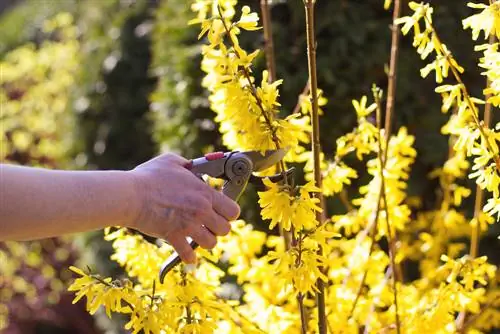
When and how should you prune forsythia?
Forsythias should be cut immediately after flowering between March and May. Old, dead shoots should be removed and annual shoots should be left standing. Regular thinning promotes the abundance of flowers and prevents the plant from aging.
Pruning guarantees lush flowers - that's why cutting is so important
With a flowering period between March and May, forsythia are the classic spring bloomers among ornamental trees. They laid their flower buds in the summer of the previous year and overwintered dormant. The long-awaited golden yellow flowers unfold before the green leaves sprout.
Yourmost abundant flowersplace gold bells on thetwo-year-old long shoots and their one-year-old side branches. Only in mild wine-growing regions and gardens with a suitable microclimate do goldbells also bloom on annual long shoots. This growth behavior results in senescence within 3 to 4 years if the gardener does not prune regularly. In order for a forsythia to welcome spring with bright yellow flowers every year, the old, dead shoots must give way to make room for young long shoots with side branches.
Background
The shoots of the forsythia
All branches with a length of more than 10 cm are referred to as long shoots and those under 10 cm are called short shoots. Along the long shoots of the first summer (see Fig. 1 below), forsythia form leaf buds, but no branches yet and only in exceptional cases the first flower buds. On the annual long shoots of the following year (see Fig. 2 below), side branches initially grow and already bear the first buds. The most valuable flowering wood are the short shoots, which develop from the one-year side branches on the two-year long shoots (see Fig. 3 below).
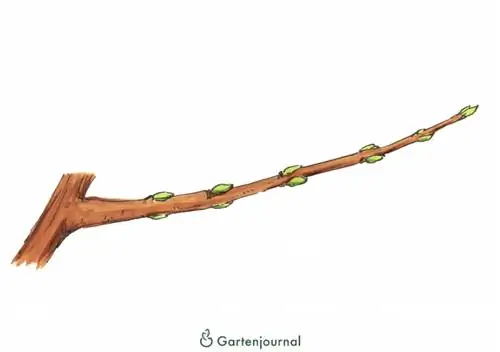

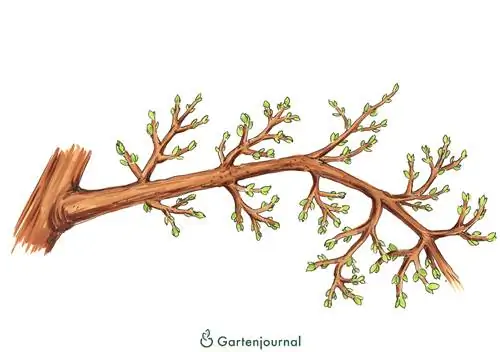
This year's long shoots are still unbranched. At the end of the second summer, the increasing branching can be clearly seen.
When is the best time?
One of the typical characteristics of the yellow heralds of spring is that they lay buds the previous year. Consequently, the prudent gardener cuts the ornamental shrubs after they have bloomed. If the scissors are used before flowering, most of the buds fall victim, so that the flowering period is disappointingly sparse. This choice of date complies with the provisions of Section 39, Paragraph 5, Federal Nature Conservation Act. It states that care and maintenance cuts are permitted during the closed season from March 1st to October 1st.
If it is a radical rejuvenation cut - as will be explained in detail later in this tutorial - the legal regulations must be observed. However, this circumstance is not a problem, since winter is, from a botanical point of view, the best season to plant an old shrub on the tree.
Instructions for care and maintenance cutting
Over the course of the first 3 to 4 years of growth, forsythia form a framework with up to 12 stronger ground shoots, on which the flower-bearing long shoots with numerous, lushly flowering side branches develop. At the end of the flowering period of the third year, we recommend the first care and maintenance cut. From this point on, the older ground and long shoots lose considerable vitality, so that they tend to age. Furthermore, scaffolding shoots from the first hour hinder the emergence of fresh ground shoots, which are essential for the growth of fresh flowering wood. How to cut the forsythia correctly:
- Cut off wilted flower shoots
- Thin out 2 to 3 of the oldest ground shoots, as shown in the illustration below
- Cut back close to the ground or shorten to a strong, young side branch
- Cut off all stunted shoots or shoots directed towards the interior of the bush at the base
- Cut off strongly branched, broom-like branches up to a one- or two-year-old long shoot
- Remove the weaker ones from long shoots that are too close together
By thinning out some of theoldest, balding shoots every year, the forsythia bush experiences continuous rejuvenation. Thanks to this pruning care, you will never be faced with the problem of putting the ornamental tree on the tree because it is completely old.
Tip
As a beginner in professional forsythia pruning, are you wondering how you can distinguish the branches according to their age? Simply mark the shoots with different colored rings from the first year onwards. Over the years you will gain a practiced eye for the developmental stage of a branch and can do without the markings.
Excursus
Encourage branching
A planting cut improves rapid rooting of young forsythia and contributes to lush branching. To do this, cut back all main shoots by two thirds between November and March. On this occasion, weak and damaged shoots are removed. However, this measure significantly affects the first flowering period.
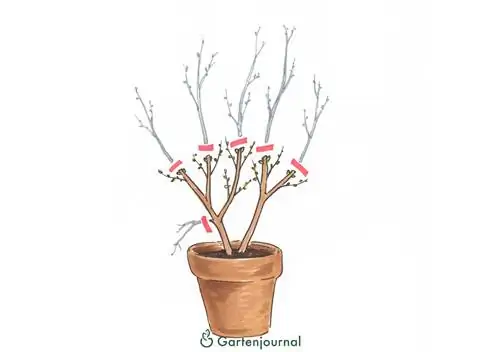
You can postpone the planting cut to a date in April or May if you want to enjoy the first flowers.
Instructions for the rejuvenation cut
If pruning care is neglected for many years on a forsythia, the flowering bush turns into an impenetrable bush without any significant flowers or leaves. Thanks to Goldglockchen'sexcellent cutting tolerance, you don't have to throw in the towel. Instead of clearing the ornamental tree, stimulate the growth of fresh shoots with a step-by-step rejuvenation cut. The older and more bare an ornamental tree, the more intermediate steps there should be. How to do it professionally:
- Rejuvenate aged forsythia in stages over 2 or 3 years
- The best time is in late winter before the flowering period on a frost-free day
- First stage: Remove ground shoots except for the 4 strongest ones, which are cut by half
- Result: new long shoots sprout directly from the ground
- Ideal case: young long shoots also sprout from the shortened old shoots
- Second stage: shorten the 4 to 8 most vital young ground shoots to different heights, remove all other young shoots
- Result: a new framework is formed from annual long shoots with side branches
- Second or third stage: cut off the 4 old ground shoots just above the root disc, provided they do not have any new long shoots
- Result: Development of a harmonious shrub crown with one- to two-year-old long and short shoots that bloom for the first time
When selecting ground shoots to be removed, please consider whether they still have fresh side branches or not. If a lateral, one- to two-year-old branch sprouts from an old scaffolding shoot, cut back to this point and not to the ground. If after the first stage no new long shoots form from the rootstock at all over the course of the summer, it is better to replace the old forsythia.
How to achieve the perfect cutting technique - instructions for beginners
If you shorten long, weak or old shoots on your forsythia, please always cuta short distance from a bud A distance of 2 to 3 millimeters guarantees rapid sprouting and rapid wound healing. If the cut is made too close to the growing point, the bud will dry out. If you leave a stub that is too long, there is a great risk that the shoot will gradually die at this point and the wound will not close. Rotting wood offers a perfect target for pathogens.
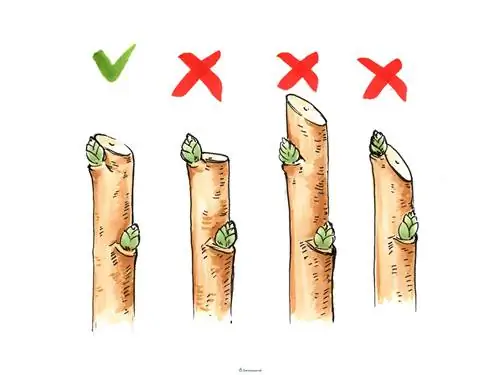
The ideal cut is made at a short distance from a bud. Place the scissors or saw at a slight angle so that the cut leads away from the bud. Please do not leave any stubs.
If old or excess shoots need to be thinned out, please cut them to Astring. To do this, look for a small bulge located between the trunk or main shoot and the side shoot that needs to be removed. This branch contains the vital, dividing tissue that must not be injured so that the wound heals in an exemplary manner. Place the cutting tool at a slight angle so that rainwater can drain away quickly. Again, no stub should be left that would cause problems for the astring as it gradually rots back.
Excursus
The best cutting tool
The right tools are the key to success when pruning your forsythia. The basic equipment includes one-handed pruning shears for branches up to 2 cm thick, with either a bypass or anvil function. Two-handed pruning shears should be available for cutting shoots that are 2 to 3.5 cm thick. In practice, the handy folding saw has proven to be useful for cutting thick shoots inside the bush with a diameter of more than 4 cm. On cuts the diameter of a 2 euro coin, you will need a knife to smooth the edges of the wound. Important:Sharpen and disinfect the blades please before and after each use. The most common cause of the spread of diseases and pests on garden plants is contaminated cutting tools.
Fertilizing optimizes the cutting result - tip for post-treatment
Following care and maintenance pruning, forsythia do not take a long rest. Rather, the ornamental trees are tackling the floral preparations for next year's flower festival. Over the course of the summer, fresh long shoots thrive and the most valuable flowering wood sprouts from the previous year's shoots along with other short shoots. By late summer, goldbells have positioned all the buds. To ensure that the growth process does not stall due to a lack of nutrients, provide the busy golden bells with an organic fertilizer.
Distribute 3 liters of mature compost and 100 grams of horn shavings per square meter of bed area. Please rake in the fertilizer lightly and re-water. Forsythia in the pot get vital growth momentum by adding a liquid fertilizer to the irrigation water.
Important facts in brief - cutting profile
The specific growth behavior of forsythia dictates the expert approach to pruning. If you have any doubts about what will happen in the middle of editing, remember these important facts. The following profile summarizes all aspects that are important for exemplary pruning care for forsythia:
- Growth: wide, upright, summer-green flowering shrub
- Growth height: 200 to 300 cm, dwarf varieties 100 to 150 cm
- Growth rate: 20 to 30 cm per year
- Flowering time: depending on the variety between March and May
- Special feature: flowers appear before the leaves
- Bud planting: in the summer of the previous year
- Flowering wood: two-year-old long shoots with one-year-old, lateral short shoots
- Exceptions: in mild winter locations already on annual long shoots
- Winter hardiness: frost-resistant down to -20 degrees Celsius
- Cutting tolerance: very good
- Poison content: slightly toxic
The low toxic content of forsythia is due to various alkaloids and saponins. This fact is relevant for home gardeners who suffer from allergies. For reasons of caution, we recommend wearing gloves in this case to prevent direct contact with the plant sap when cutting.
Frequently asked questions
Cutting dwarf forsythia - what should you pay attention to?
For small gardens and large containers, nurseries offer forsythia varieties that grow to a height of 100 to 150 centimeters. Characteristic of the weakly growing ornamental trees are very short shoot sections between the individual buds; in technical jargon called internodes. This growth results in dense, flower-rich branching that does not require annual maintenance pruning. At intervals of 2 to 3 years, we recommend cutting back half of all branches by a third to keep them blooming. You can use this opportunity to thin out over-aged or stunted shoots on Astring.
When and how should a forsythia hedge be trimmed?
Forsythias have conquered a place among the most popular hedge plants as flower-rich messengers of spring. In warm, protected locations, the one-year-old long shoots bloom, followed by the two-year-old shoots with numerous side branches. With regular care and maintenance trimming, as explained in this tutorial, you can effectively prevent baldness. In contrast to cutting a solitary forsythia, choose a date in June or July because the growth has passed its peak at this point and the well-groomed appearance is maintained for longer.
When making cuts, ideally aim for a trapezoidal shape with a wide base that tapers towards the crown of the bush. This ensures that sunlight penetrates into the interior of the hedge and stimulates buds there to grow.
The 3 most common mistakes when cutting forsythia
In ornamental gardens and parks you can often discover forsythia that are only a shadow of their former self. As a result of neglected pruning care, the once flower-rich ornamental trees have been transformed into leafless and flowerless thickets. It is primarily the following three errors that are responsible for the floral dilemma. The following overview names the omissions, points out the consequences and gives tips for correction:
| Error | Episode | Correction |
|---|---|---|
| Cut in winter | Loss of most buds, almost complete loss of flowering period | cut immediately after the end of the flowering period |
| not exposed | densely branched bushes of over-aged, balding ground shoots, a few flowering shoots on the edge, arching long shoots with a few flowers on the tips of the shoots | Rejuvenation pruning in winter, then cut off the oldest ground shoots every year, thin out dead wood regularly |
| radically rejuvenated in one go | no fresh shoots, forsythia dies | rejuvenate aged shrubs in 2 to 3 stages |

Tip
In the tutorial you can read that forsythia produce their buds the previous year. Consequently, the ornamental trees are among the ideal suppliers for magical Barabara branches. Saint Barbara celebrates her name day on December 4th. This is the deadline for cutting branches from forsythia and spring-flowering fruit trees. In a water-filled vase on the sunny, warm window seat, the branches are in full bloom just in time for Christmas Eve.

